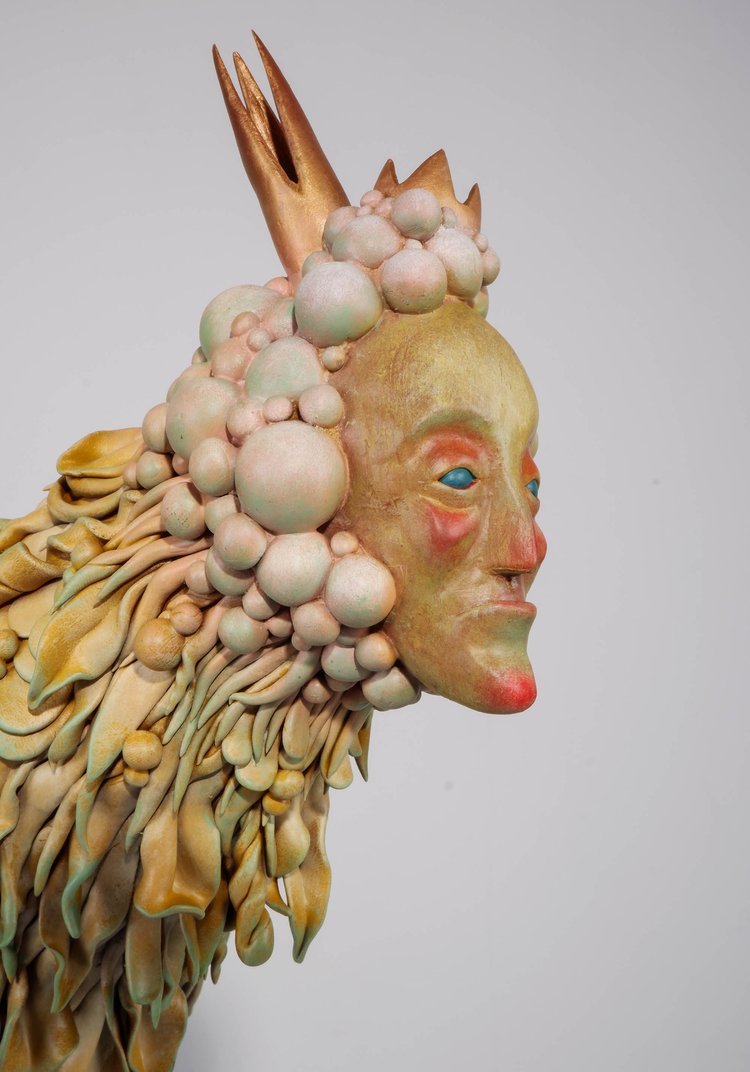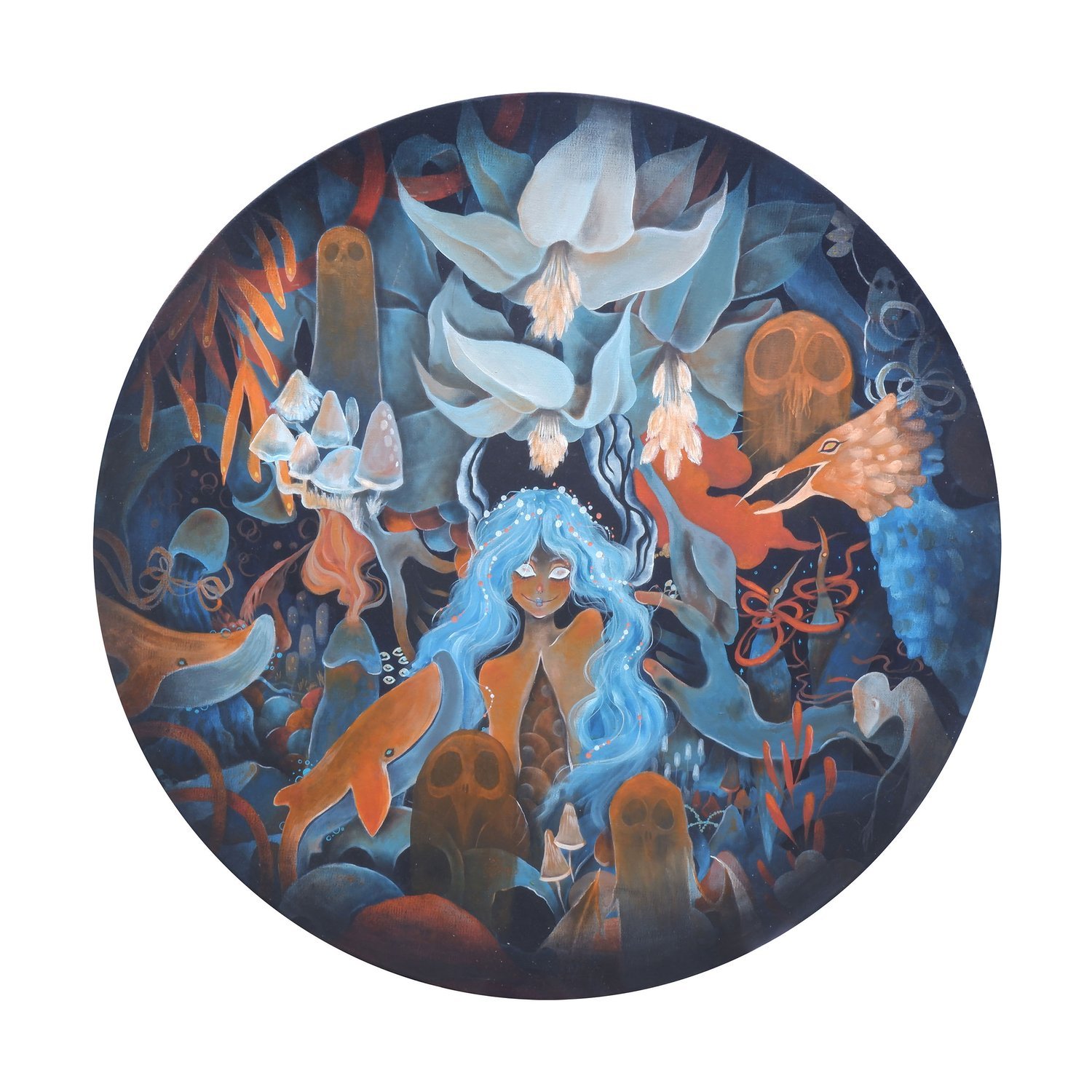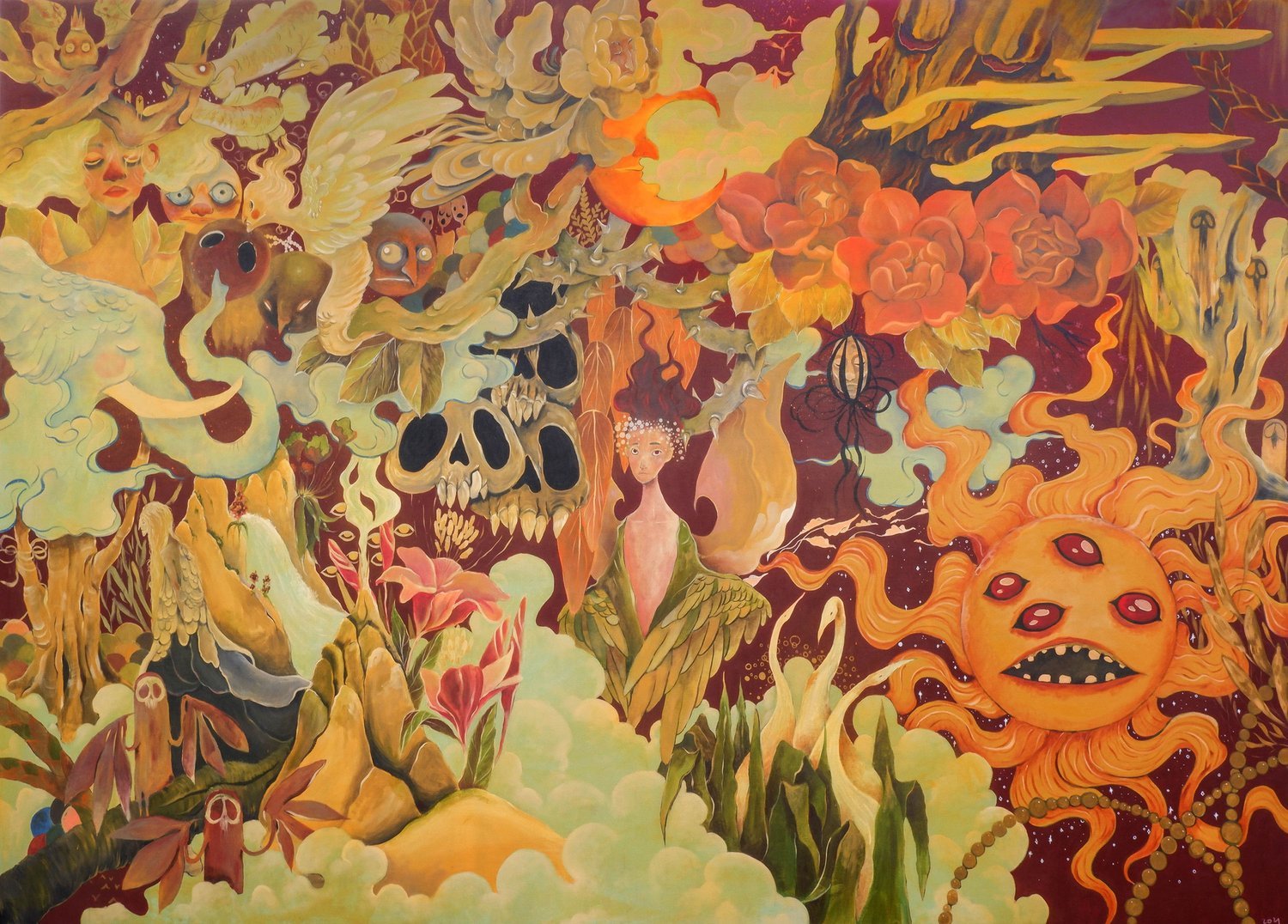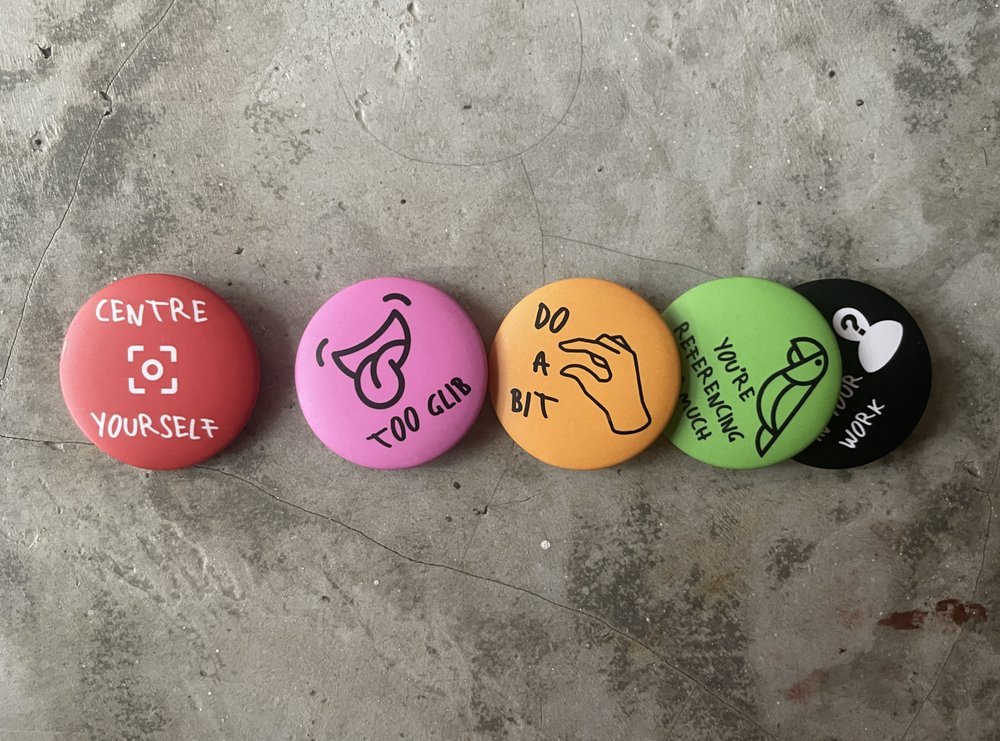Curatorial Notes on ‘Conviction’
Solo exhibition by Indonesian artist Atreyu Moniaga
By Nin Djani
Over the years, we have republished parts of long-form writing, from catalogue essays to book chapters. This practice is now formalised as part of our ‘Excerpts’ series. To read other writings from the series, click here.
Atreyu Artax Moniaga, Details of ‘The Debris of Ambition’, 2021, watercolor on paper, 100 x 100cm. Image courtesy of the artist and Kohesi Initiatives.
One of the keys to happiness is to accept sadness as part of the realities in life. That being said, this is not an encouragement nor an excuse for us to dwell in our own pessimism and stop every attempt in our pursuit of happiness. Instead, this is a call to cultivate a new mindset in understanding sadness, anger, and disappointments, not as negative emotions that need to be resisted or avoided, but as a moment or opportunity to reflect and understand ourselves.
Nevertheless, for the longest time, sadness and art have been associated as two sides of the same coin, in which depressive episodes have served as inspirations for artists – from poets, musicians, to visual artists – in producing their works. Therefore, it is unsurprising that we may have, inadvertently, perpetuated the myth of the tortured artists, which romanticises frustrated feelings, chronic fatigue, anxiety, and mental stress as the prerequisites for the creative process. We admire figures like actor Robin Williams, poet Sylvia Plath, and painter Vincent van Gogh as the creative geniuses who produced extraordinary works because of their mental conditions. In recent years, as conversations around mental health become more widespread, we realise just how this mindset is wrong and dangerous. Williams, Plath, and van Gogh were the exceptions – their remarkable achievements in spite of their conditions were not common, and we all know the tragic way their stories ended. Prolonged sadness, depression, and sufferings are not to be normalised and glorified as the price of creative and artistic genius. Research has shown that being at peace and in good health are important factors that help us optimise our creativity and improve our artistic abilities. Then, what about artists who still use sadness as the source of inspiration for their process?
Atreyu Artax Moniaga, Details of ‘Bravado’, 2021, Acrylic paint on epoxy clay sculpture, 34.9 x 25.7 x 53.9cm. Image courtesy of the artist and Kohesi Initiatives.
Atreyu Artax Moniaga, ‘Ophidia’, 2021, Acrylic paint on epoxy clay sculpture, 50.5 x 34.8 x 42.1cm. Image courtesy of the artist and Kohesi Initiatives.
Atreyu Moniaga is aware that sadness is the fuel that drives his artistic process. Since he was young, drawing and painting have become his way to process complex emotions that he cannot express in words. As a daily journal, visual art is his safe space, a sanctuary where he can pour his most personal thoughts without the fear of being judged by others. Through the symbols that he creates, Atreyu develops a visual language and his own secret world. With such a degree of privacy in his symbols and language, he is conscious of the tendency that some people may simplify his practice as an insular process that is limited to his own personal space. However, this simplification overlooks Atreyu’s external exploration process that is as extensive as his internal interrogation. This seemingly cryptic, obscure, and undecipherable language carries references from popular culture and art history, so upon closer examination, there is actually a way to interpret his semiotics.
Atreyu Artax Moniaga, Details of ‘The Search for Temperance’, 2021, watercolor on paper, 100 x 100cm. Image courtesy of the artist and Kohesi Initiatives
Atreyu’s works, both the new pieces produced for this exhibition and his previous oeuvre, already have several identifiable signature symbols: Sjajh, the sun with multiple eyes, crescent moon, giant whale, arowanas, snakes and dragons, roses and foliage, fairies and nymphets, little boys, and many others. These elements come together in colourful compositions that stir our emotions. Some of his works, especially in his early career, are monochromatic, dominated by subdued pastels that sway us in serene sentimentality. While this softer tone has become one of his trademarks, recent works have shown some bolder moves with contrasting, vivid colors that emanate the burning passion and intensity. Either way, there is one thing that is present in both compositions: Atreyu’s paradoxical universe of imaginations. His paintings are scenes from fantasy lands that are both intriguing and terrifying, where on one hand we are mesmerised by the spectacular visuals, and yet on the other hand there is this eerie mystery that cannot be construed.
Portrait of Atreyu Artax Moniaga. Image courtesy of the artist and Kohesi Initiatives.
The fantasy elements in Atreyu’s works that lull the spectators through its color combinations and symbolisms can be rooted back to Japanese manga and culture. This is unsurprising, considering it was manga that first sparked his interest in art. His childhood dream to become a manga-ka or a comic author motivated him to learn how to draw. Manga series such as Magic Knight Rayearth by CLAMP, Shaman King by Hiroyuki Takei, Saint Seiya: Knights of the Zodiac by Masaki Kurumada, and Sailor Moon by Naoko Takeuchi were among the major inspirations that kept him drawing. Years later, to this day, traces of these manga maestros can still be discovered in the line strokes, symbolisms, character design, and contrasting colours he incorporates in his paintings. In addition to manga, contemporary photography by Tim Walker and Sebastião Salgado are also influential in the ways Atreyu injects elements of theatricality and glamour in his visual universe, thus in his more mature works, we can see how all these symbols have blended in unison.
Atreyu Artax Moniaga, ‘Decadence’, 2021, oil on canvas, diameter 100cm. Image courtesy of the artist and Kohesi Initiatives
The subjects and content of his work are developed through his explorations into emotionally complex themes in the works by film director Guillermo del Toro and visual artist Yoshitaka Amano. Both creators are his main inspirations in developing a fantasy, idyllic world that combines childlike innocence with horror and melancholy. His love for symbolism is supplemented with his penchant for a rich narrative that compels him to expand his references into ancient mythologies, especially biblical stories, and medieval legends. This is because similar to the modern narratives developed by del Toro and Amano, ancient mythologies are filled with tragic stories wrapped in epic heroism. Through these stories, Atreyu learns to find ways to transform his sadness, disappointments, and bad memories into a colourful universe, filled with beauty and grandeur that may not be accessible in the chaotic real world. While some may feel this contradiction as provoking disturbance, for Atreyu, this anomaly is a form of idealism. This is influenced by the music of Jewel, a singer he has idolised since childhood. He draws a parallel between his visual works and her folk-country music arrangement, in the sense that her music sounds simple and sweet at first, but when we listen closely, we can have a deeper understanding of the sad stories behind the poetic lyrics. Thus, Atreyu’s work is a layered and lyrical visual experience. To truly grasp the extent of his artistry, we cannot just see his works as decorative compositions that please the eye, instead, we have to be mindful of the changing sensations that emerge when we look at the details in the composition with our soul.
“To truly grasp the extent of his artistry, we cannot just see his works as decorative compositions that please the eye, instead, we have to be mindful of the changing sensations that emerge when we look at the details in the composition with our soul.”
Consisting of more than 40 new artworks that include 26 paintings, 24 sculptures, and collaboration series, ‘Conviction’ is an artistic achievement both as a visual exploration and technique application. In his first large-scale solo exhibition, Atreyu has exhibited his mastery of watercolour paintings on paper and oil paintings on canvas – the two main mediums of his works. However, as a young artist with enthusiasm and curiosity, this exhibition has also become an opportunity to introduce his latest venture in three-dimensional artworks, in the form of sculptures of variable shapes and dimensions. In addition, this project also includes two collaborative series with Rama Dauhan and Show the Monster, which may well be an indication of his future explorations – after this exhibition – into the world of fashion and new media art.
Atreyu Artax Moniaga, ‘Conviction’, 2022, oil on canvas, 180 x 250cm. Image courtesy of the artist and Kohesi Initiatives
Beyond this visual and technical accomplishment, ‘Conviction’ is also significant in other ways. As his second solo exhibition, ‘Conviction’ is a starting point of a new chapter in his artistic career, but on a personal level, this exhibition is a milestone of a long process to muster some courage and confidence to accept himself as an individual with all his strength and shortcomings. Sentimental, personal stories and light observations into his surroundings remain a recurring theme of this exhibition, therefore ‘Conviction’ is also a form of public confession that reveals Atreyu’s private emotions and contemplations.
The above text is an abridged version of the curatorial essay for ‘Conviction’, a solo exhibition by Indonesian artist Atreyu Moniga, showcasing more than 40 new artworks, including paintings, and a more recent experimentation with sculptures. Curated by Nin Djani, the show includes ‘A Seismogarm of Conviction’, which is a series of 8 works that document the artist’s changing moods during the pandemic.
‘Conviction’ is on show from 19 February 2022 to 3 April 2022 at Kohesi Initiatives.
For the full curatorial essay and more information about the exhibition, visit here.
To read other writings from the Excerpts series, click here.













